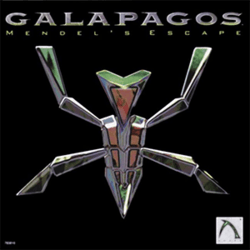Galapagos (video game)
| Galapagos | |
|---|---|
 | |
| Developer(s) | Anark Game Studios |
| Publisher(s) | Electronic Arts (US), Sega (JP) |
| Platform(s) | Microsoft Windows, Mac OS |
| Release date(s) |
Microsoft Windows Mac OS |
| Genre(s) | Action, Simulation |
| Mode(s) | Single-player |
Galapagos: Mendel's Escape is a computer action game developed by Anark Game Studios and published by Electronic Arts in 1997. It is perhaps best known for its use of "artificial life technology" to control the main character, only giving the player indirect control of the creature by manipulating the environment.
Gameplay
The main character of Galapagos is AI-controlled and only indirectly responds to changes the player makes to its environment. This character is capable of maneuvering through the environment while avoiding surfaces and obstacles it has previously learned is harmful, entirely on its own.
However, the creature does not know how to manipulate the levers and switches found throughout the various areas in the game, so it is up to the player to help. As it moves around, the camera angle changes to reveal the new obstacles. Correct manipulation of the devices, through puzzle solving and careful timing, is needed to succeed.
Story
A synthetic bug-like creature known as Mendel (named after Gregor Mendel, the founder of Mendelian genetics) has just been created in a dystopian lab in the world of Galapagos (a reference to the Galapagos Islands). Mendel is the first of its kind, a prototype which will one day be used to create an army of "belligerent autonomous agents, to be used as instruments of dominion, to conquer other worlds for the exploitation of their resources". Mendel turns out completely harmless and lonely, so they instead plan to study and dissect the creature to continue their plans of creating a "xenocidal war machine". The player character has full control over the laboratory environment and wishes to subvert their plans by helping Mendel escape from the lab, and ultimately leave Galapagos.
Development
The technology used to create Mendel's artificial intelligence is a proprietary system called Non-stationary Entropic Reduction Mapping, or NERM.[3] NERM was designed to be self-organizing, meaning that it does not require prior knowledge of the system that it controls.[3]
The environments in Galapagos were created with a proprietary tool called Leveller.[3]
Reception
| Reception | ||||||||||||
|---|---|---|---|---|---|---|---|---|---|---|---|---|
| ||||||||||||
Reviewers were split on Galapagos: Mendel's Escape. While all praised its innovative use of the NERM system to control Mendel, whether that contributed to an enjoyable game experience was debatable. Common points of complaint included the slow movement for Mendel, the poor camera angles, and the frustration of waiting for Mendel to make the correct decisions.
Stephen Poole of GameSpot described the NERM system as "a technology in search of a home", concluding that the game could be described in four words: "great idea, questionable implementation".[4]
Kathy Tafel of MacAddict said of the game, "it can be exceedingly frustrating. [...] in Galapagos the game moves the camera at will (although it's generally centered on Mendel). This can make parts of the game almost impossible to play."[5]
References
- 1 2 "Galapagos: Mendel's Escape for PC". GameRankings. Retrieved 2014-05-19.
- 1 2
- 1 2 3 "Galapagos". Next Generation. Imagine Media (12): 116–9. December 1995.
- 1 2 Poole, Stephen (1997-12-15). "Galapagos: Mendel's Escape Review". GameSpot. Retrieved 2014-05-19.
- ↑